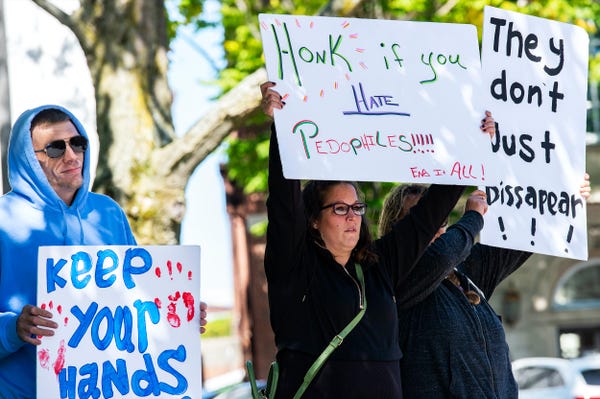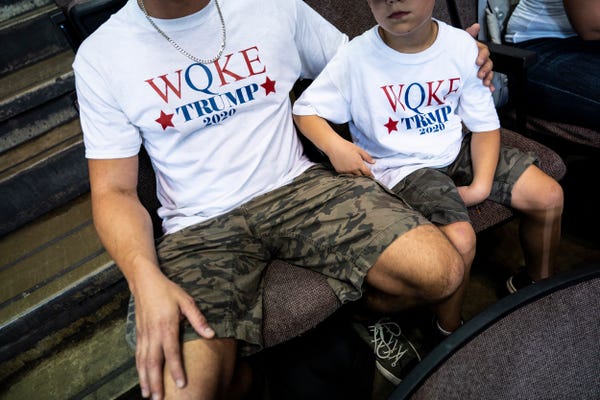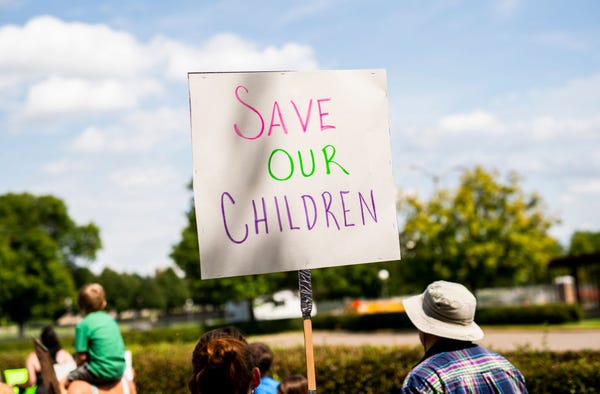Sex-trafficking survivors say QAnon conspiracy theories cause damage
Christy Croft, a sex-trafficking survivor and activist, was scrolling through social media in July when they came across a debunked conspiracy theory claiming that the furniture company Wayfair was selling kidnapped children.
At the time, hundreds of thousands of people on social media were discussing the falsehood. Croft decided to look into the conspiracy theory after seeing that other survivors and fellow anti-trafficking professionals were criticizing it.
“I was appalled — and immediately frustrated with the really strong pushback I encountered with people when I tried to correct misinformation,” Croft told Insider.
The accusation about Wayfair, traced back to the larger conspiracy theory QAnon, is not true. Wayfair has denied claims it is trafficking children, and the claim has been debunked by Snopes, independent fact-checkers, and many journalists.
This wasn’t the first time Croft encountered misinformation while working as an activist against sex trafficking. But Croft has noticed an uptick, driven by the QAnon movement’s ability to spread misinformation so easily.
At its core, QAnon is premised on the baseless conspiracy theory that President Donald Trump is secretly fighting a cabal of satanic pedophiles and cannibals. One of its most prominent preoccupations is the false notion that Democratic elites run a vast pedophilic sex-trafficking ring.
QAnon theories, Croft told Insider, make it harder to fight misinformation about the real-life problem and hijack attention from the cause. Croft and other sex-trafficking survivors told Insider the discredited theories were exploitative and, oftentimes, infuriating.
“As a survivor, when I see it, I feel exploited again,” Croft said. “I feel like my trauma and the trauma of people like me is being exploited for purposes other than ending trafficking.”
QAnon appropriates the real-life problem of sex trafficking
Croft said QAnon believers often questioned and attempted to discredit work done by survivors, accusing them of being “part of the cover-up.”
“It’s really infuriating when you have survivors who have lived experience and are working full time in this field and have helped tons and tons of survivors saying ‘Actually that’s not quite right,’” Croft said. “And you have someone with no experience and no professional expertise with a whole day of internet research on unverified sites telling you: ‘You don’t know your own life.’”

Suamhirs Piraino-Guzman, who as a child was kidnapped from his hometown in Honduras, smuggled into the US by human traffickers, and repeatedly sexually assaulted, told Insider the anti-trafficking movement had been fighting “huge amounts of misinformation” for years.
“It’s really difficult for people to really differentiate the super-sensationalization of human trafficking,” Piraino-Guzman, who worked on President Barack Obama’s US Advisory Council on Human Trafficking, said. “People don’t really know what human trafficking is, and they’re creating these type of stories distract from the real issue.”
As Insider’s Rachel Greenspan has reported, QAnon believers package their sex-trafficking conspiracy theories “into simple, hard-to-challenge ‘Save the Children’ rhetoric” that’s been spread across the internet, leading to fundraisers, protests, and rallies calling for help to prevent trafficking.

Members of the movement, which originated on the internet message board 4chan and is considered by the FBI as a risk for domestic terrorism, spread the false “Pizzagate” claim that Hillary Clinton and other elite Democrats ran a sex-abuse ring from a Washington, DC, pizzeria.
In recent months, followers have also claimed that phishing scam texts sent by people posing to be with the US Postal Service were part of a human-trafficking scheme.
But QAnon’s anti-trafficking campaign, which has been supported by numerous candidates in the November US election, relies on exaggerated data, false accusations of children being kidnapped from their homes, and partisan rhetoric.
Ultimately, hard data on sex trafficking is hard to establish — some organizations recirculate out-of-date statistics, while others avoid producing credible research on the topic, according to the HuffPost reporter Michael Hobbes, who wrote an article detailing the difficulty in finding hard numbers on the issue.
The very premise that Trump has a particularly hard stance against child sex trafficking is also dubious, as federal prosecutions of those cases have fallen under his presidency.
When conspiracy theories distract from real solutions
Piraino-Guzman said that by sharing misinformation, people were avoiding acknowledging larger issues when it came to trafficking, like helping vulnerable communities.
“It’s easier to scream like bloody hell that there is an issue here rather than actually doing something to acknowledge that maybe we are consuming products that are produced by forced labor, or we are maybe staying in hotel rooms where somebody has been sexually exploited,” he said.
According to the anti-trafficking organization Polaris Project, vulnerable communities are most at risk of being trafficked, which the Department of Justice defines as “exploiting a person for labor, services, or commercial sex.”
Sex traffickers normally target vulnerable communities by luring them in with “offer of food, clothes, attention, friendship, love, and a seemingly safe place to sleep,” according to the Department of Justice.

Most often, factors including recent relocation, substance use, mental-health issues, involvement in child welfare, homelessness, or being a runaway can put a person at risk of being trafficked, Polaris Project said.
When it comes to child sex trafficking, LGBTQ youth are at particular risk because they make up 40% of homeless youth, Polaris said. Polaris says girls in Black communities are also at higher risk, primarily because they’re likely to live in underserved areas.
KD Roche, a survivor of child sex trafficking who consults for numerous anti-trafficking organizations, told Insider that many vulnerable children had been unable to find safe spaces in schools or with their counselors because of the coronavirus pandemic.
Roche, who wrote a book about his own survivor story called “Fragments: A Post-Traumatic Paradigm,” added that he’d spent time at trainings and webinars answering questions about QAnon and its Pizzagate and Wayfair conspiracy theories.
“I’ve definitely noticed this push of ‘Save the Children’ while simultaneously ignoring the problem that exists, that has left these kids vulnerable to trafficking to begin with,” Roche said. “It’s working against the work we’re already doing and it’s taking up a big chunk of time.”

Piraino-Guzman advised people to take trainings through the anti-trafficking organization Freedom Network USA. The organization helps educate people on how to identify sex trafficking and at-risk and vulnerable communities, and advocates on behalf of survivors transitioning out of trafficking.
“It starts with having a well-educated community on what human trafficking is,” he said.
Croft said people looking to help prevent sex trafficking should work to help ensure people’s needs were met in the community.
“It’s a lot harder to exploit people who are getting their needs met through other ways,” Croft said. “So if people’s needs for income and housing and safety and food and mental-health treatment are already being met, these traffickers will have less leverage. So focusing on providing people with social support and wellness, filling in some of those gaps in our safety net, is trafficking prevention.”
*** This article has been archived for your research. The original version from Insider can be found here ***


